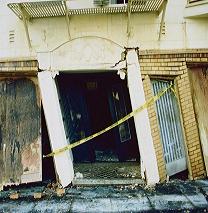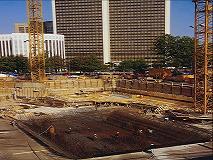The Department of Buildings ensures the safe and lawful use of 950,000 properties and buildings in New York City by enforcing the Building Code and Zoning Resolution. The DOB maintains a Building Information System and DOB NOW which is an informative website you may find helpful in your research.
Notices of violations are issued for violators in various categories, and vary from DOB violations, ECB violations, and criminal summonses. Not all violations are adjudicated. The advice of an experienced consultant can make a difference.
Does it have to be this obvious?
Section 28-301.1 (27-127) of the Building Code -Maintenance requirements, all buildings and all parts thereof shall be maintained in a safe condition. All service equipment, means of egress, devices, and safeguards that are required in a building by the provisions of this code or other applicable laws or regulations, or that were required by law when the building was erected, altered, or repaired, shall be maintained in good working order. Actually, maintenance should really reflect the quality of construction.
The DOB monitors construction in NYC from approving plans, inspecting the construction site for the sake of public safety, etc. If conditions permit, a violation is issued as a form of enforcement procedure, or a “stop work order” may be issued and thus not allow you to continue any work other than making the construction site safe, if it is necessary.
Violations:
The Dept. of Buildings issues a variety of violations, ranging from violations that do not carry a fine, to criminal summonses which can lead to an arrest warrant. Most violations issued, are simply an order to correct a violating condition. Some violations qualify for a hearing at the Environmental Control Board (ECB), where you may present a defense to dismiss the violation.
You must comply with LL110 of 2019 where applicable.
Admit and Pay:
Respondents who received a Department of Buildings violation, and wish to admit the charge, can pay the minimum penalty by mail anytime before – or on the day of – the scheduled hearing date at the ECB.
Contest:
To deny the charge of the violation, you must attend the hearing at ECB on the date provided. The presiding Hearing Officer (or ALJ) may accept testimony and evidence and forward their recommendation to the Commissioners’ designee for a final decision and order.
Non-hazardous violations:
You have three options:
-
- Cure – You can file a certificate of correction with the DOB. In it, you admit that the condition or conditions causing the violation existed, and you sign and notarize a statement that states you corrected the condition(s). This must be filed within 35 days from the day the violation was issued, to avoid a fine for the violation and avoid having to appear at the Environmental Control Board (ECB) before an Administrative Law Judge (ALJ) at a hearing. But if you file the certificate late, or if an inspector inspects the building and finds that you didn’t really correct the condition, you must appear at the hearing, where you can then challenge the violation. You may only certify correction if the entire condition alleged on the notice of violation were corrected. In the event that the issuing offer cited two or more violating conditions, they must all be corrected before the certificate of correction will be approved. After you certify correction of the violation, the DOB should send you a letter letting you know that it has accepted your certificate of correction. If you didn’t get this letter, you should appear at the ECB hearing.
- Contest – You may choose to appear before an ALJ on the hearing date indicated on the notice of violation to challenge the violation. For example, say you get a violation for making illegal alterations. If you don’t want to remove those alterations, you may want to challenge the violation by showing the ALJ why they aren’t illegal.
- Stipulation – If you have been offered a stipulation agreement, for which you admit the alleged violating condition and are required to pay a minimum fine, you have an opportunity to extend the correction period from 35 to 90 days, depending on the alleged violation. Keep in mind though, that you must enter into the stipulation agreement by the date indicated on the offer.

Hazardous or Repeat Offender Violations:
You must appear before an ALJ at a hearing on the date listed in the violation notice. At the hearing, you can either show that you corrected the violation or challenge the allegation altogether, or the hazardous designation. Be aware that for these options it is likely that the case will be adjourned for the issuing officers’ testimony.
ECB Violation Penalty Structure:
1. Base penalty, depending if severity is a class 1 or class 2 designation. View the details of the classification guideline.
2. Aggravated 1 – (2.5 X Penalty Increase, 10X Default) previously known as 2nd offense.
3. Aggravated 2 – (5X Penalty Increase, Statutory Max) prepared case documenting history of non-compliance on same or related properties including:
multiple violations (various conditions),
history of unreasonable delays in correcting violations,
false filings,
injury or fatality on the place of occurrence.
Visit our ECB page for more details and to view the penalty schedule.
Hearing:
You first line of defense is to correct the violating condition. If the violation indicates a cure date which is usually 35 days from the date of the violation, you will need to file the certificate of correction. In addition you may qualify for a mitigated penalty for non-hazardous first offender violation. You may avoid the hearing process altogether by accepting a stipulation offer if you need more time to correct the violation. There are basically three types of ways to defend a violation at the ECB,
o jurisdictional defense,
o meritorious defense,
o technical defense.
If you plan to defend yourself, you will need to provide evidence to support your claim. However, if you use a meritorious defense, the Issuing officer might be requested and the case will be adjourned for a later time and day. If you feel confident to handle this process, you might want to give it your best and be successful. We compiled a list of the most common ten defenses you can use to challenge your DOB violations, if it applies to your situation. M. Ben Reich offers the service of representing its clients at these proceedings for a reasonable fee. Taking into account the thousands of cases and appeals it handled you can be assured that your case will get the proper representation you expect.
Solution:
Unless there was an admission, the decision of the ALJ is appeal-able, if you believe there was an error in law interpretation or finding of facts, provided that the penalty must be paid in advance. The appeal must be filed with the ECB within 30 days from the mailing date of the decision, and served upon the issuing agency as well.
Correction:
Correcting and removing these violations is in itself a form of art. There are different procedures for different violations. Some require a re-inspection, while for others you need to file specific forms (see below for some forms you can download), or just by simply paying a penalty etc.
You may have noticed that we used separately the term “correcting” and “removing”, since they are many times unrelated and as a result require different actions.
Class 1 – 60 Day rule:
Enacted by the NYS Senate, effective January 28th 2010, the Dept. of Buildings is now required to accept certificates of correction for all classes of violation immediately after the violation was issued. However, class 1 designated violations will incur a civil penalty of $1,500.00-$5,000.00 if certifying later than 60 days which will be collected at the time of certifying correction. Additionally, violations for failure to certify correction may also be issued. You can view the complete text of the law, or a sample notice of violation for failing to timely certify correction.
~~~~~~~~~~~~~~~~~~~~~~~~~~~~~~~
Helpful Resources
Dept. of Buildings Code
Certificate of Correction, & Supporting Statement
Pay Class 1 civil penalty
AEU 3321 Required Training
Elevator PVT Correction
LL 110 of 2019 poster
Work permit requirement & exemption
Civil Penalty Waiver Application
LL 11 of 1998 façade checklist
Boiler ECB violation
DOB refund application
DOB FOIL Request
Essential & Non-Essential Construction During COVID-19
Confirm safety training requirements, Site Safety Construction Map
cycle 9 façade amnesty program
LL126 of 2021 Parapet wall annual inspection
